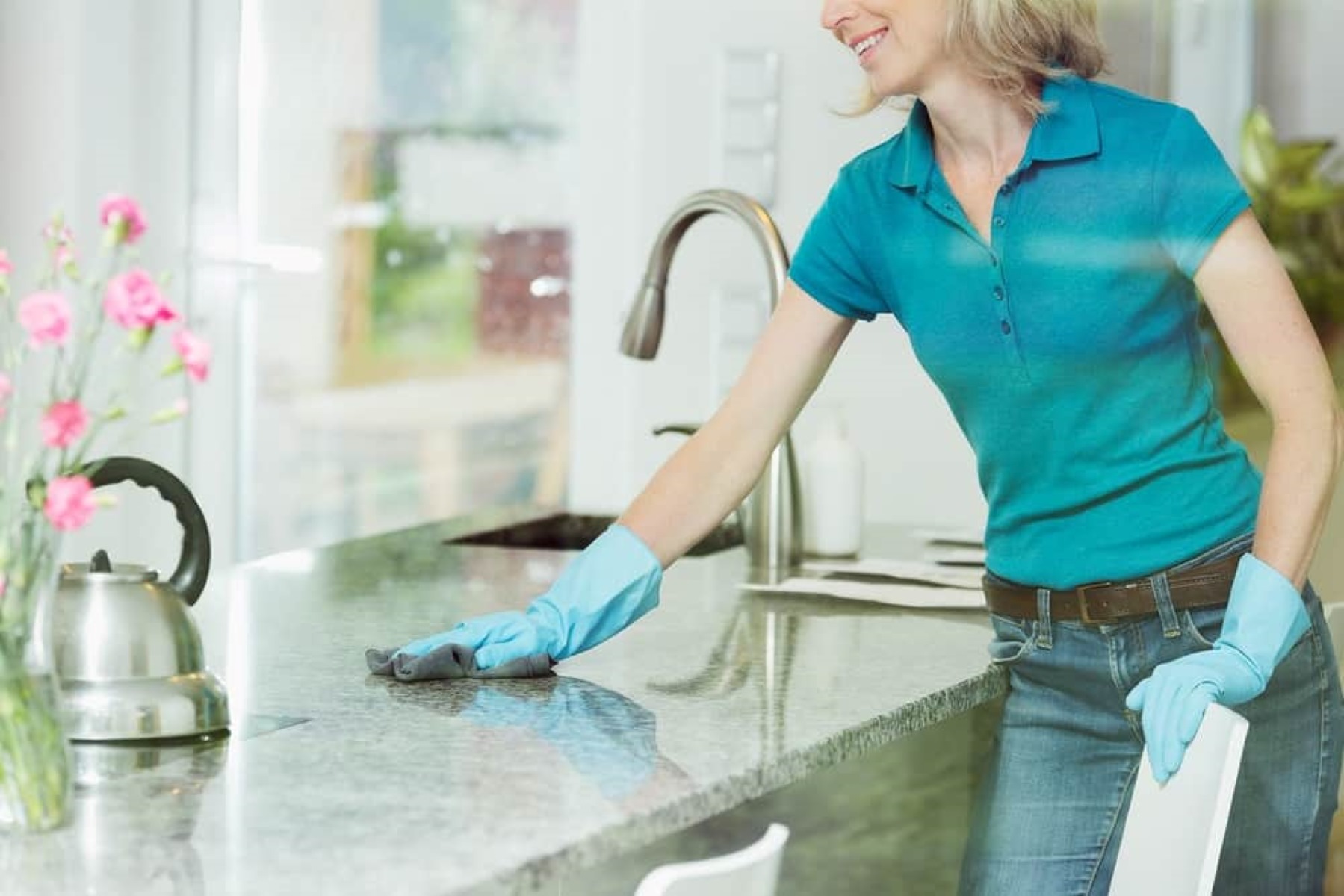

Articles
How To Clean And Disinfect Quartz Countertops
Modified: February 28, 2024
Learn the best methods for cleaning and disinfecting quartz countertops in this informative article. Keep your countertops looking pristine and germ-free with these helpful tips.
(Many of the links in this article redirect to a specific reviewed product. Your purchase of these products through affiliate links helps to generate commission for Storables.com, at no extra cost. Learn more)
Introduction
Quartz countertops have become increasingly popular in modern kitchens and bathrooms due to their durability and elegant appearance. Made from a combination of natural quartz stone and resins, these countertops offer a unique blend of strength and beauty. However, just like any other surface in your home, quartz countertops require regular cleaning and maintenance to keep them looking their best.
Properly cleaning and disinfecting quartz countertops not only helps to remove dirt and stains but also ensures a hygienic environment in your kitchen or bathroom. In this article, we will guide you through the step-by-step process of cleaning and disinfecting your quartz countertops, as well as provide you with some additional tips to maintain their pristine condition.
Before we dive into the cleaning process, it’s important to understand the nature of quartz countertops. Unlike natural stone countertops, such as granite or marble, quartz countertops are engineered and have a non-porous surface. This non-porous characteristic makes quartz countertops resistant to staining and harboring bacteria, making them an excellent choice for homeowners looking for a low-maintenance option.
However, despite being resistant to stains, quartz countertops can still accumulate debris, such as food crumbs and spills, on their surface. Regular cleaning is essential to prevent the build-up of dirt and maintain the countertop’s shine. In addition, it’s crucial to disinfect quartz countertops to eliminate any harmful bacteria that may come into contact with the surface.
Before we begin the cleaning process, there are a few important tips to keep in mind:
- Avoid using abrasive or acidic cleaners, as they can damage the quartz surface.
- Always use soft cleaning tools, such as microfiber cloths or non-abrasive sponges, to avoid scratching the countertop.
- Wipe up spills immediately to prevent them from staining the surface.
- Test any new cleaning products on a small, inconspicuous area of the countertop to ensure no damage or discoloration occurs.
Now that you have a better understanding of quartz countertops and the importance of regular cleaning, let’s move on to the step-by-step process of cleaning and disinfecting these beautiful surfaces.
Key Takeaways:
- Properly cleaning and disinfecting quartz countertops is essential to maintain their beauty and hygiene. Use gentle cleaners, avoid harsh chemicals, and follow manufacturer guidelines for best results.
- Regular maintenance, including wiping up spills, using cutting boards, and protecting against UV damage, will help preserve the elegance and longevity of quartz countertops. Prevention and care are key.
Read more: What Are Quartz Countertops
Understanding Quartz Countertops
Quartz countertops are engineered stone surfaces made primarily from natural quartz crystals and a small amount of resin. The quartz crystals are mined, usually from quarries, and ground into a fine powder. This powder is then mixed with resin and other additives to create a solid and durable slab.
One of the main advantages of quartz countertops is their non-porous nature. Unlike natural stone countertops, which are porous and can absorb liquids and stains, quartz countertops are highly resistant to staining. This non-porous characteristic also makes quartz countertops more hygienic, as bacteria and germs cannot easily penetrate the surface.
Quartz countertops come in a wide range of colors and patterns, thanks to the availability of different types of quartz crystals. Manufacturers can control the appearance of the countertops by varying the size and color of the quartz crystals used in the production process. This allows homeowners to find the perfect quartz countertop to complement their kitchen or bathroom décor.
Another advantage of quartz countertops is their durability. The combination of natural quartz crystals and resin creates a strong and resilient surface that is resistant to scratches and chips. However, it is still important to use cutting boards and avoid placing hot pots and pans directly on the surface to prevent any potential damage.
Maintaining the beauty and longevity of quartz countertops requires regular cleaning and care. While quartz is a low-maintenance material, it is not completely maintenance-free. Regular cleaning helps to remove dirt, oils, and food particles that can accumulate on the surface over time.
It is important to note that even though quartz countertops are highly resistant to staining, certain substances can still cause discoloration if left untreated. For example, acidic liquids like lemon juice, vinegar, or wine can etch the surface of the countertop if not promptly cleaned up. That’s why it’s crucial to wipe up spills immediately and avoid using abrasive or acidic cleaners on quartz countertops.
By understanding the unique characteristics and benefits of quartz countertops, you can effectively maintain their beauty and functionality. In the next section, we will delve into the step-by-step process of cleaning and disinfecting quartz countertops to keep them looking pristine for years to come.
Important Tips Before Cleaning
Before you start cleaning your quartz countertops, there are a few important tips to keep in mind to ensure effective and safe cleaning:
- Read the manufacturer’s instructions: Different quartz countertop brands may have specific cleaning recommendations, so it’s essential to consult the manufacturer’s instructions before you begin cleaning. Following their guidelines will help you maintain the warranty and ensure proper care for your countertops.
- Gather the necessary supplies: Before you start cleaning, make sure you have all the supplies you need. This will save you time and ensure you have everything on hand to complete the task. You will need a few soft, non-abrasive cloths or microfiber towels, a gentle dish soap or a pH-neutral quartz cleaner, warm water, and a spray bottle.
- Remove any loose debris: Before applying any cleaning solution, it’s important to remove any loose debris or crumbs from the surface of the countertop. Use a soft cloth or a gentle brush to gently wipe away any loose dirt or food particles. This will prevent scratching the surface when you start cleaning.
- Avoid abrasive cleaners and tools: Quartz countertops are durable, but using abrasive cleaners or tools can damage the surface. Avoid using harsh scrub brushes, scouring pads, or abrasive cleaners that contain bleach or ammonia. Instead, opt for soft cloths, non-abrasive sponges, or microfiber towels to clean the countertops.
- Avoid strong chemicals: While quartz countertops are resistant to staining and highly durable, certain chemicals can still cause damage. Avoid using strong chemicals or solvents on your countertops as they can break down the resin and create a dull or discolored appearance. Stick to gentle dish soap or a pH-neutral quartz cleaner for effective cleaning.
- Test new cleaning products: If you’re considering using a new cleaning product on your quartz countertops, it’s a good idea to test it on a small, inconspicuous area first. Apply a small amount of the cleaner and let it sit for a few minutes. If there is no discoloration or damage, you can proceed to use it on the rest of the countertop.
By following these important tips, you can ensure that your cleaning process is effective, safe, and does not damage your quartz countertops. Now that you are prepared with the necessary knowledge, let’s move on to the step-by-step cleaning process to keep your quartz countertops sparkling clean.
Supplies Needed
Before you begin cleaning your quartz countertops, gather the following supplies:
- Soft, non-abrasive cloth or microfiber towels: These will be used for wiping and buffing the countertops. Choose cloths that are gentle on the surface to avoid scratching or dulling the quartz.
- Gentle dish soap or pH-neutral quartz cleaner: Look for a mild dish soap that does not contain harsh chemicals or additives. Alternatively, you can use a specialized quartz cleaner that is specifically formulated to be safe on quartz surfaces. Avoid using abrasive or acidic cleaners, as they can damage the countertop.
- Warm water: You will need warm water for diluting the cleaning solution and rinsing the countertops. Make sure the water is not too hot to avoid damaging the quartz.
- Spray bottle: A spray bottle will be useful for mixing and dispensing the cleaning solution. It allows for easy application and even distribution of the cleaner on the countertop surface.
- Optional: Isopropyl alcohol or vinegar: Isopropyl alcohol or white vinegar can be used as additional cleaning agents for stubborn stains or greasy residue. These ingredients help break down and remove tough grime on the surface of the quartz countertop.
- Soft brush or non-abrasive sponge: In some cases, you may need a soft brush or non-abrasive sponge to gently scrub away any stubborn stains or dried-on food particles. Choose a brush or sponge with soft bristles to avoid scratching the quartz surface.
- Lint-free cloth or paper towel: A lint-free cloth or paper towel is ideal for drying the countertops after cleaning. These materials won’t leave behind lint or fibers that can mar the surface of the quartz.
Having these supplies on hand will ensure that you are well-equipped to clean your quartz countertops effectively and without causing any damage. Now that you have everything ready, let’s proceed to the step-by-step cleaning process.
Step-by-Step Cleaning Process
Follow these step-by-step instructions to effectively clean your quartz countertops:
Read more: How To Clean Rust Off Quartz Countertops
Step 1: Removing Surface Debris
Start by removing any loose debris or crumbs from the countertop surface. Use a soft, non-abrasive cloth or a gentle brush to sweep away any dirt or food particles. This will prevent scratching the surface during the cleaning process.
Step 2: Preparing the Cleaning Solution
In a spray bottle, mix a small amount of gentle dish soap or a pH-neutral quartz cleaner with warm water. Follow the manufacturer’s instructions for the proper dilution ratio. Shake the bottle gently to ensure the solution is well-mixed.
Step 3: Applying the Cleaning Solution
Spray the cleaning solution onto the quartz countertop. Be careful not to oversaturate the surface. The goal is to apply a thin and even layer of the cleaning solution over the entire countertop.
Step 4: Scrubbing and Wiping
Using a soft brush or non-abrasive sponge, gently scrub the countertop surface in circular motions. Focus on any areas with stains or dried-on residue. Continue scrubbing until the surface is clean and any stubborn spots have been loosened.
Once you have scrubbed the countertop, use a soft, non-abrasive cloth or microfiber towel to wipe away the cleaning solution. Work in a circular motion, removing any remaining grime or residue from the surface. Repeat this step if necessary to achieve a clean and streak-free result.
Read more: How To Disinfect Kitchen Countertops
Step 5: Rinsing and Drying
Rinse the countertop thoroughly with warm water to remove any leftover cleaning solution. Ensure that all traces of soap or cleaner have been completely rinsed away. Use a lint-free cloth or paper towel to dry the countertop, gently buffing the surface to remove any water spots or streaks.
And there you have it! By following these steps, you can maintain the cleanliness and beauty of your quartz countertops. However, cleaning alone is not enough to ensure a completely hygienic surface. In the next section, we will explore the process of disinfecting quartz countertops to eliminate bacteria and germs.
Step 1: Removing Surface Debris
Before starting the cleaning process, it’s important to remove any loose debris or crumbs from the surface of your quartz countertops. This step will prevent scratching the surface when you begin to clean and also ensure that the cleaning solution can effectively penetrate and clean the quartz.
To remove surface debris, follow these steps:
- Gather a soft, non-abrasive cloth or a gentle brush: Choose a cloth or brush that won’t scratch or damage the quartz surface. Microfiber cloths or gentle brushes with soft bristles are ideal for this purpose.
- Start from one end of the countertop: Begin the debris removal process from one end of the countertop and work your way across, covering the entire surface area.
- Gently wipe or brush the surface: Use the cloth or brush to sweep away any loose debris or crumbs from the countertop. Be gentle to avoid scratching the surface. If there are any stubborn crumbs, you can use a brush with soft bristles to gently dislodge them.
- Pay attention to edges and corners: Ensure that you reach the edges and corners of the countertop, as debris tends to accumulate in these areas. Use the cloth or brush to carefully clean these hard-to-reach spots.
- Dispose of the debris: As you clean, collect the debris in a dustpan or use a damp cloth to gather and dispose of it in the trash. Regularly shake off the cloth or brush to remove accumulated debris.
By taking the time to remove surface debris, you are creating a clean and clear canvas for the subsequent steps of the cleaning process. This ensures that the cleaning solution can effectively reach the quartz surface, allowing for a more thorough and satisfactory cleaning result.
Now that you have successfully removed the loose debris from your quartz countertops, you are ready to proceed to the next step: preparing the cleaning solution. Stay tuned for the next section as we guide you through the process of creating an effective cleaning solution for your quartz countertops.
Step 2: Preparing the Cleaning Solution
Once you have removed the surface debris from your quartz countertops, it’s time to prepare the cleaning solution. The cleaning solution you choose should be gentle yet effective in removing dirt, stains, and grease without causing any damage to the quartz surface.
- Gather your supplies: You will need a spray bottle, warm water, and a gentle dish soap or a pH-neutral quartz cleaner.
- Determine the dilution ratio: Check the instructions provided by the manufacturer of the dish soap or quartz cleaner to determine the appropriate dilution ratio. Different products may have different dilution recommendations, so it’s essential to follow the instructions for the best results.
- Fill the spray bottle with warm water: Fill the spray bottle with warm water, leaving enough space to add the cleaning solution. The warm water will help dissolve the dish soap or quartz cleaner and improve its effectiveness.
- Add the dish soap or quartz cleaner: Measure the specified amount of gentle dish soap or pH-neutral quartz cleaner and add it to the spray bottle containing the warm water. Be careful not to use excessive amounts of cleaning solution, as it may leave a residue on the countertop surface.
- Secure the spray bottle cap and shake well: Make sure the spray bottle cap is securely fastened, and then shake the bottle gently to mix the water and cleaning solution together. This will ensure a well-blended cleaning solution.
It’s important to note that using abrasive or acidic cleaners, as well as bleach or ammonia-based products, can damage the quartz surface. Stick to gentle dish soap or pH-neutral quartz cleaners specifically formulated for cleaning quartz countertops. These products are designed to effectively clean without compromising the integrity of the quartz material.
By preparing the cleaning solution correctly, you are setting yourself up for a successful and efficient cleaning process. In the next step, we will guide you through the process of applying the cleaning solution to your quartz countertops.
Step 3: Applying the Cleaning Solution
Now that you have prepared the cleaning solution, it’s time to apply it to your quartz countertops. Applying the cleaning solution evenly across the surface will help break down dirt, stains, and grease, making it easier to remove them during the cleaning process.
- Ensure the spray bottle is properly filled: Check that the spray bottle containing the cleaning solution is properly filled and that the spray nozzle is functional. This will allow for easy and even application of the solution.
- Hold the spray bottle at a distance: Position yourself in front of the quartz countertop and hold the spray bottle about 6-8 inches away from the surface. This distance will help ensure even coverage and prevent oversaturation.
- Spray the cleaning solution onto the countertop: Press the spray nozzle on the bottle to release a fine mist of the cleaning solution onto the quartz countertop. Begin at one end of the countertop and move in a sweeping motion, covering the entire area. Make sure to apply a thin and even layer of the solution.
- Focus on problem areas: If there are any particularly stubborn stains or grease spots, apply a bit more cleaning solution directly on those areas. This will allow the solution to penetrate and work on removing the tough residue.
- Let the cleaning solution sit for a few minutes: After applying the cleaning solution, allow it to sit on the quartz countertop surface for a few minutes. This will give it time to break down any dirt or stains effectively.
By applying the cleaning solution properly, you are ensuring that it reaches all areas of the quartz countertop, allowing for effective cleaning and stain removal. In the next step, we will discuss the process of scrubbing and wiping the countertops to remove any dirt and residue. Stay tuned!
Read more: How To Refinish Quartz Countertops
Step 4: Scrubbing and Wiping
After allowing the cleaning solution to sit on your quartz countertops for a few minutes, it’s time to start scrubbing and wiping the surface. This step is crucial in removing dirt, stains, and grease effectively.
- Choose a soft brush or non-abrasive sponge: Select a soft brush with gentle bristles or a non-abrasive sponge to scrub the quartz countertops. Avoid using abrasive materials or harsh scrub brushes that can damage the surface.
- Gently scrub the countertop surface in circular motions: Dip the brush or sponge in warm water to moisten it, and then begin scrubbing the countertop surface in circular motions. Focus on areas with stubborn stains or grime, applying gentle pressure to remove the dirt without harming the quartz.
- Continue scrubbing until the surface is clean: Pay attention to any specific areas or spots that may require extra attention. Keep scrubbing until the surface is clean and free from any visible dirt, stains, or grease.
- Wipe away the cleaning solution: Take a soft, non-abrasive cloth or microfiber towel and gently wipe away the cleaning solution from the countertop surface. Work in circular motions to ensure all residue is removed. It’s important to avoid leaving any cleaning solution behind as it can leave streaks or a film on the surface.
- Inspect the countertop for any remaining spots: After wiping away the cleaning solution, inspect the quartz countertop for any remaining spots or stains. If there are still stubborn stains present, repeat the scrubbing process with a bit of additional cleaning solution.
Remember, when scrubbing your quartz countertops, it’s essential to be gentle and avoid using excessive force. Quartz is a durable material, but aggressive scrubbing or using abrasive tools can cause scratches or damage the surface.
Once you have completed the scrubbing and wiping process, your quartz countertops should look clean and refreshed. In the next step, we will discuss the rinsing and drying process to ensure a spotless and streak-free finish. Keep reading!
Step 5: Rinsing and Drying
After scrubbing and wiping the quartz countertops, it’s important to thoroughly rinse away any remaining cleaning solution and residue. This step is crucial to achieve a spotless and streak-free finish, ensuring your countertops look pristine.
- Prepare warm water for rinsing: Fill a clean container or sink with warm water. Make sure the water is at a comfortable temperature, but not too hot, as excessive heat can potentially damage the quartz surface.
- Rinse the countertop surface: Take a soft, non-abrasive cloth or sponge and saturate it in the warm water. Wring out any excess water, leaving the cloth or sponge damp but not dripping. Then, gently wipe down the entire surface of the quartz countertop to rinse away any remaining cleaning solution.
- Repeat rinsing if necessary: If you notice any visible residues or suds on the countertop surface after the initial rinse, repeat the process with fresh warm water. Thoroughly rinsing ensures that no cleaning solution is left behind, which can lead to streaks or a film on the quartz surface.
- Dry the countertop: Once the rinsing process is complete, use a lint-free cloth or paper towel to dry the quartz countertop. Gently buff the surface in circular motions to remove any remaining moisture and to achieve a streak-free finish.
- Inspect the countertop: After drying, inspect the quartz countertop for any lingering spots or streaks. If you notice any, simply dampen a clean cloth with warm water and gently wipe the affected area to remove them. Dry the surface again with a dry cloth to ensure a flawless appearance.
Remember to avoid using abrasive materials or scrub brushes during the rinsing process, as they can potentially scratch the quartz surface. Stick to soft cloths or sponges to gently remove the cleaning solution residue.
By thoroughly rinsing and drying your quartz countertops, you can achieve a clean and polished look. In the next section, we will discuss the importance of disinfecting quartz countertops and provide step-by-step instructions to ensure a hygienic surface. Stay tuned!
Disinfecting Quartz Countertops
While regular cleaning helps to remove dirt and stains from quartz countertops, disinfecting is necessary to eliminate bacteria and germs that may be present on the surface. Disinfecting is especially important in areas like the kitchen and bathroom, where food preparation and personal hygiene take place. By effectively disinfecting your quartz countertops, you can create a cleaner and healthier environment.
It’s important to note that quartz countertops are naturally resistant to bacteria and germs due to their non-porous surface. However, occasional disinfection is still recommended, especially during times when extra precautions are necessary, such as during illness outbreaks or flu seasons.
When disinfecting your quartz countertops, it’s crucial to use the right disinfectant to ensure effectiveness without damaging the quartz surface. Follow these steps to properly disinfect your countertops:
- Step 1: Choosing the Right Disinfectant
- Step 2: Preparing the Disinfecting Solution
- Step 3: Applying the Disinfecting Solution
- Step 4: Letting the Disinfectant Sit
- Step 5: Wiping and Drying
Start by selecting a disinfectant that is safe for use on quartz surfaces. Look for disinfectants that specifically state they are suitable for use on non-porous surfaces or for use on quartz countertops. Avoid using bleach or abrasive cleaners, as they can harm the quartz material.
Follow the instructions on the disinfectant product to properly prepare the solution. Dilute it according to the recommended ratio, using warm water if necessary. Be sure to wear gloves and protect your eyes and skin as recommended by the manufacturer.
Spray or apply the disinfecting solution onto the quartz countertop, ensuring complete coverage. Use a spray bottle or a clean cloth to apply the solution, depending on the specific instructions provided by the disinfectant manufacturer.
Allow the disinfectant to sit on the quartz countertop for the recommended contact time specified by the manufacturer, usually between 3 to 5 minutes. This ensures sufficient time for the disinfectant to effectively kill bacteria and germs.
After the contact time has elapsed, use a clean cloth or paper towel to wipe away the disinfecting solution. Make sure to remove all residue to prevent streaks or film from forming. To dry the countertop, gently buff the surface with a dry cloth for a polished finish.
By following these steps, you can effectively disinfect your quartz countertops, ensuring they are free from harmful bacteria and germs. Regularly disinfecting your countertops, especially in high-contact areas, helps maintain a hygienic environment in your kitchen or bathroom.
Now that you know how to disinfect your quartz countertops properly, we will move on to the additional tips for maintaining their pristine condition. Keep reading to learn more!
Step-by-Step Disinfecting Process
To ensure a hygienic and bacteria-free surface, it’s important to disinfect your quartz countertops regularly. Follow these step-by-step instructions to properly disinfect your countertops:
- Step 1: Choosing the Right Disinfectant
- Step 2: Preparing the Disinfecting Solution
- Step 3: Applying the Disinfecting Solution
- Step 4: Letting the Disinfectant Sit
- Step 5: Wiping and Drying
Start by selecting a disinfectant that is safe for use on quartz surfaces. Look for disinfectants that specifically state they are suitable for use on non-porous surfaces or for use on quartz countertops. Avoid using bleach or abrasive cleaners, as they can harm the quartz material.
Follow the instructions on the disinfectant product to properly prepare the solution. Dilute it according to the recommended ratio, using warm water if necessary. Be sure to wear gloves and protect your eyes and skin as recommended by the manufacturer.
Spray or apply the disinfecting solution onto the quartz countertop, ensuring complete coverage. Use a spray bottle or a clean cloth to apply the solution, depending on the specific instructions provided by the disinfectant manufacturer.
Allow the disinfectant to sit on the quartz countertop for the recommended contact time specified by the manufacturer, usually between 3 to 5 minutes. This ensures sufficient time for the disinfectant to effectively kill bacteria and germs.
After the contact time has elapsed, use a clean cloth or paper towel to wipe away the disinfecting solution. Make sure to remove all residue to prevent streaks or film from forming. To dry the countertop, gently buff the surface with a dry cloth for a polished finish.
When disinfecting your quartz countertops, always follow the instructions provided by the disinfectant manufacturer. This will ensure proper usage and maximize the effectiveness of the disinfecting solution without compromising the integrity of the quartz surface.
By regularly disinfecting your quartz countertops, you can maintain a sanitary surface free from harmful bacteria and germs, especially in high-contact areas such as kitchen countertops or bathroom vanities.
Now that you are familiar with the step-by-step disinfecting process, let’s move on to some additional tips for maintaining the beauty and longevity of your quartz countertops.
Use a mild dish soap and warm water to clean quartz countertops. For disinfecting, use a mixture of water and rubbing alcohol in a 1:1 ratio, and avoid harsh chemicals.
Read more: How To Seam Quartz Countertops
Step 1: Choosing the Right Disinfectant
When it comes to disinfecting your quartz countertops, selecting the right disinfectant is crucial. Not all disinfectants are suitable for use on quartz surfaces, as some may contain harsh chemicals that can damage the quartz material. It’s important to choose a disinfectant that is specifically formulated for use on non-porous surfaces, such as quartz countertops. Follow these guidelines to choose the right disinfectant:
- Read the label: Look for disinfectants that explicitly state they are safe for use on non-porous surfaces or for use on quartz countertops. Read the label carefully to ensure that the disinfectant is compatible with quartz.
- Avoid bleach and harsh chemicals: Avoid using bleach or disinfectants that contain bleach, as they can cause discoloration or damage to the quartz surface. Similarly, avoid disinfectants with harsh chemicals, such as ammonia or abrasive ingredients, as they can also harm the quartz material.
- Opt for pH-neutral disinfectants: Choose disinfectants that are pH-neutral, as they are generally safe for use on quartz surfaces. pH-neutral disinfectants are formulated to maintain the integrity of the quartz without causing any harm or etching.
- Consider natural disinfectants: If you prefer to use natural cleaning products, there are natural disinfectants available that are safe for use on quartz countertops. Look for disinfectants that contain natural ingredients like vinegar, hydrogen peroxide, or essential oils, as these can effectively sanitize the surface without causing any damage.
- Consult the manufacturer’s recommendations: If your quartz countertops are under warranty, it’s essential to consult the manufacturer’s recommendations for disinfecting. Some manufacturers may provide specific guidelines or recommend certain disinfectant brands that are suitable for use on their quartz countertops.
By choosing the right disinfectant, you can effectively sanitize your quartz countertops without compromising their beauty or durability. Always follow the instructions provided by the disinfectant manufacturer for proper usage, dilution ratios, and contact times. This will ensure the best results and help maintain the longevity of your quartz countertops.
Now that you know the importance of choosing the right disinfectant, let’s proceed to the next step: preparing the disinfecting solution. Stay tuned!
Step 2: Preparing the Disinfecting Solution
Now that you have chosen the right disinfectant for your quartz countertops, it’s time to prepare the disinfecting solution. Properly diluting the disinfectant ensures its effectiveness in killing bacteria and germs without damaging the quartz surface. Follow these steps to prepare the disinfecting solution:
- Read the instructions: Carefully read the instructions provided by the disinfectant manufacturer. The instructions will specify the recommended dilution ratio and any specific guidelines for preparing the disinfecting solution.
- Gather your supplies: Make sure you have all the necessary supplies, including the disinfectant, a measuring cup or spoon, and warm water.
- Measure the disinfectant: Follow the recommended dilution ratio specified by the manufacturer and measure out the required amount of disinfectant. This ensures that the disinfecting solution is properly balanced and effective.
- Add warm water: Fill a container or spray bottle with warm water. The warm water will help to dissolve and activate the disinfectant. Make sure the water is not too hot, as excessive heat can potentially damage the quartz surface.
- Mix the disinfectant and water: Add the measured disinfectant to the container or spray bottle containing the warm water. Gently stir or shake the container to thoroughly mix the disinfecting solution.
- Label the container: If you are preparing a larger quantity of disinfecting solution for future use, be sure to label the container with the date of preparation and the name of the disinfectant. This will help you keep track of its freshness and ensure you use the correct solution when disinfecting your countertops.
It’s important to follow the manufacturer’s instructions carefully when preparing the disinfecting solution. Each disinfectant may have different dilution ratios, and using too much or too little of the disinfectant can impact its effectiveness. Improperly diluted disinfectant may not adequately sanitize the quartz countertop surface.
By properly preparing the disinfecting solution, you can effectively kill bacteria and germs on your quartz countertops while maintaining their integrity. In the next step, we will guide you through the process of applying the disinfecting solution to your countertops. Stay tuned!
Step 3: Applying the Disinfecting Solution
After preparing the disinfecting solution for your quartz countertops, it’s time to apply it to the surface. Applying the disinfecting solution evenly and thoroughly ensures effective sanitation and helps eliminate bacteria and germs. Follow these steps to properly apply the disinfecting solution:
- Ensure proper ventilation: Before applying the disinfecting solution, ensure that the area is well-ventilated. Open windows or turn on ventilation fans to allow for proper air circulation.
- Use protective gloves: Wear protective gloves to prevent any potential skin irritation or chemical contact with the disinfecting solution. This is particularly important if the disinfectant contains strong chemicals or if you have sensitive skin.
- Prep your application tool: Depending on the disinfectant and its instructions, choose an appropriate application tool. This could be a spray bottle, a clean cloth, or a disposable wipe, as recommended by the manufacturer.
- Apply the disinfecting solution: Spray or apply the disinfecting solution onto the quartz countertop surface. Ensure complete coverage, including all areas that may have come into contact with potential contaminants, such as food preparation areas or high-touch surfaces.
- Allow sufficient contact time: Follow the manufacturer’s instructions to determine the recommended contact time for the disinfecting solution. This typically ranges from a few minutes to allow the disinfectant to work effectively.
- Avoid oversaturation: While applying the disinfecting solution, be cautious not to oversaturate the quartz surface. Excessive moisture can seep into the seams or edges of the countertop, causing potential issues. If necessary, use a clean cloth to wipe away any excess liquid.
By following these steps, you can ensure that the disinfecting solution is applied properly and thoroughly, maximizing its effectiveness in eliminating bacteria and germs on your quartz countertops.
In the next step, we will discuss the importance of letting the disinfectant sit on the surface for the recommended contact time. Keep reading!
Step 4: Letting the Disinfectant Sit
Once you have applied the disinfecting solution to your quartz countertops, it’s important to let it sit for the recommended contact time. Allowing the disinfectant to remain on the surface for the specified duration ensures that it effectively kills bacteria and germs. Follow these steps to properly let the disinfectant sit:
- Consult the manufacturer’s instructions: Refer to the instructions provided by the disinfectant manufacturer to determine the recommended contact time. Each disinfectant may have different requirements, so it’s essential to follow the specific guidelines.
- Avoid disturbing the disinfectant: During the contact time, avoid touching or disturbing the disinfectant on the countertop surface. This allows the disinfectant to work undisturbed and ensures maximum effectiveness in killing bacteria and germs.
- Maintain proper ventilation: Keep the area well-ventilated during the contact time, as some disinfectants may have strong odors. Proper ventilation helps dissipate any fumes and ensures a safe environment.
- Keep the surface undisturbed: Minimize activities or objects that could potentially disrupt or contaminate the quartz countertop surface while the disinfectant is sitting. This helps maintain a clean and hygienic environment.
- Set a timer: To ensure the appropriate contact time, set a timer or use a clock to track the duration. This will help you accurately determine when it’s time to proceed to the next step in the disinfection process.
- Avoid rinsing prematurely: It’s crucial to let the disinfectant sit for the full recommended contact time before moving on to the next step. Premature rinsing may diminish the effectiveness of the disinfectant, compromising its ability to eliminate bacteria and germs.
By allowing the disinfecting solution to sit for the recommended contact time, you ensure that it has sufficient opportunity to thoroughly eliminate bacteria and germs on the quartz countertop surface.
In the next step, we will guide you through the process of wiping away the disinfectant and ensuring a clean and dry countertop. Keep reading!
Read more: How To Polish Quartz Countertops
Step 5: Wiping and Drying
After letting the disinfectant sit on your quartz countertops for the recommended contact time, it’s time to wipe away the disinfectant and ensure a clean and dry surface. Proper wiping and drying will help remove any residue and leave your countertops looking pristine. Follow these steps to effectively wipe and dry your countertops:
- Use a clean cloth or paper towel: Choose a soft, non-abrasive cloth or a paper towel to wipe the countertop surface. Avoid using materials that may scratch the quartz, such as rough scrub brushes or abrasive sponges.
- Gently wipe the surface: Begin at one end of the countertop and wipe the surface in a consistent, circular motion. Be thorough to ensure that every area is wiped, paying extra attention to high-touch areas and potential problem spots.
- Check for any remaining disinfectant residue: As you’re wiping, inspect the countertop surface for any remaining disinfectant residue. If you notice any spots or streaks, give those areas an additional wipe with a clean, damp cloth to remove the residue.
- Dry the countertops: Once you have wiped away the disinfectant and any residue, use a separate dry cloth or paper towel to gently dry the countertop surface. This will help prevent any water spots or streaks from forming and leave the countertops looking polished.
- Inspect the countertops: After drying, inspect the quartz countertops to ensure they are clean and dry. Check for any remaining residue or streaks. If necessary, go over the surface again with a fresh, dry cloth to achieve a flawless finish.
Proper wiping and drying not only removes the disinfectant residue but also helps restore the shine and beauty of your quartz countertops. It’s important to maintain a clean and dry surface to prevent any potential damage or staining.
By following these steps, you can effectively complete the process of wiping and drying your countertops, leaving them looking spotless and hygienic.
Congratulations! You have now successfully completed the disinfection process for your quartz countertops. Regularly disinfecting your countertops helps maintain a clean and healthy environment. In the next section, we will provide additional tips for maintaining the beauty and longevity of your quartz countertops. Keep reading!
Additional Tips for Maintaining Quartz Countertops
Quartz countertops are a beautiful addition to any kitchen or bathroom, and with proper maintenance, you can keep them looking their best for years to come. Here are some additional tips to help you maintain the beauty and longevity of your quartz countertops:
- Wipe up spills immediately: Promptly wipe up any spills on your quartz countertops to prevent staining. Quartz is resistant to stains, but certain substances, like acidic liquids or oils, can cause discoloration if left for too long.
- Use mild or pH-neutral cleaners: When cleaning your quartz countertops, opt for gentle dish soap or pH-neutral quartz cleaners. Avoid using abrasive or acidic cleaners, as they can potentially damage the surface.
- Avoid harsh chemicals and solvents: Keep in mind that harsh chemicals and solvents can harm the quartz surface. Avoid using products that contain bleach, ammonia, or strong acids on your countertops.
- Use cutting boards and trivets: To prevent scratches and heat damage, always use cutting boards when slicing or chopping food. Additionally, use trivets or hot pads to protect the quartz surface from direct contact with hot pots, pans, or baking dishes.
- Be cautious with sharp objects: While quartz is highly durable, it’s best to avoid using sharp objects directly on the countertops. Use cutting boards or other protective surfaces to prevent any potential scratching or damage.
- Avoid abrasive scrubbing: Stick to soft cloths, non-abrasive sponges, or gentle brushes when cleaning or removing dirt from your countertops. Scrubbing with abrasive materials can lead to scratches or dulling of the quartz surface.
- Protect against UV damage: Prolonged exposure to direct sunlight can cause discoloration or fading of the quartz surface. Install blinds or curtains in your kitchen or bathroom to reduce UV exposure, or consider applying window film that blocks UV rays.
- Regularly reseal if necessary: Unlike natural stone countertops, quartz countertops do not require regular sealing. However, if you notice a loss of shine or water absorption, contact the manufacturer or a professional to assess if resealing is needed.
- Follow manufacturer’s guidelines: Always refer to the manufacturer’s specific guidelines for cleaning and maintenance. Different quartz brands may have slightly different care requirements, so it’s best to follow their recommendations to ensure the best care for your countertops.
By following these additional tips, you can keep your quartz countertops looking beautiful and ensure their longevity. Regular cleaning, proper care, and prompt maintenance will help maintain their pristine condition and provide you with years of enjoyment.
Remember, prevention is key when it comes to maintaining quartz countertops. By taking simple precautions and performing regular cleaning and maintenance, you can keep them looking as good as new for many years to come.
Thank you for reading! We hope these tips have been helpful in maintaining your quartz countertops. Enjoy the beauty and durability they bring to your home!
Conclusion
Quartz countertops are a popular choice for kitchens and bathrooms due to their durability, beauty, and low-maintenance nature. With proper cleaning and regular maintenance, you can ensure that your quartz countertops retain their elegance and functionality for years to come.
In this comprehensive guide, we have walked you through the step-by-step process of cleaning and disinfecting your quartz countertops. We emphasized the importance of choosing the right cleaning and disinfecting products specifically designed for quartz surfaces, as well as the significance of following manufacturer instructions and guidelines.
By removing surface debris, preparing the appropriate cleaning solution, and applying it with care, you can rid your countertops of dirt, stains, and bacteria. Regularly disinfecting your quartz countertops is essential to maintain a hygienic environment in the kitchen or bathroom.
In addition to the cleaning and disinfecting process, we provided you with valuable tips for maintaining your quartz countertops. Proper care, including promptly wiping up spills, using mild cleaners, avoiding abrasive materials, and protecting against UV damage, will help prolong the lifespan and beauty of your countertops.
Remember to consult the manufacturer’s recommendations and guidelines for your specific brand of quartz countertops, as they may have slightly different care requirements.
By following these steps and implementing these tips, you can enjoy the timeless elegance and durability that quartz countertops offer. Maintaining a clean and hygienic kitchen or bathroom not only enhances the aesthetics of your home but also promotes a healthier living environment for you and your family.
Thank you for taking the time to learn how to effectively clean, disinfect, and maintain your quartz countertops. We hope this guide has been informative and helpful to you. Enjoy the beauty and functionality of your quartz countertops for many years to come!
Frequently Asked Questions about How To Clean And Disinfect Quartz Countertops
Was this page helpful?
At Storables.com, we guarantee accurate and reliable information. Our content, validated by Expert Board Contributors, is crafted following stringent Editorial Policies. We're committed to providing you with well-researched, expert-backed insights for all your informational needs.



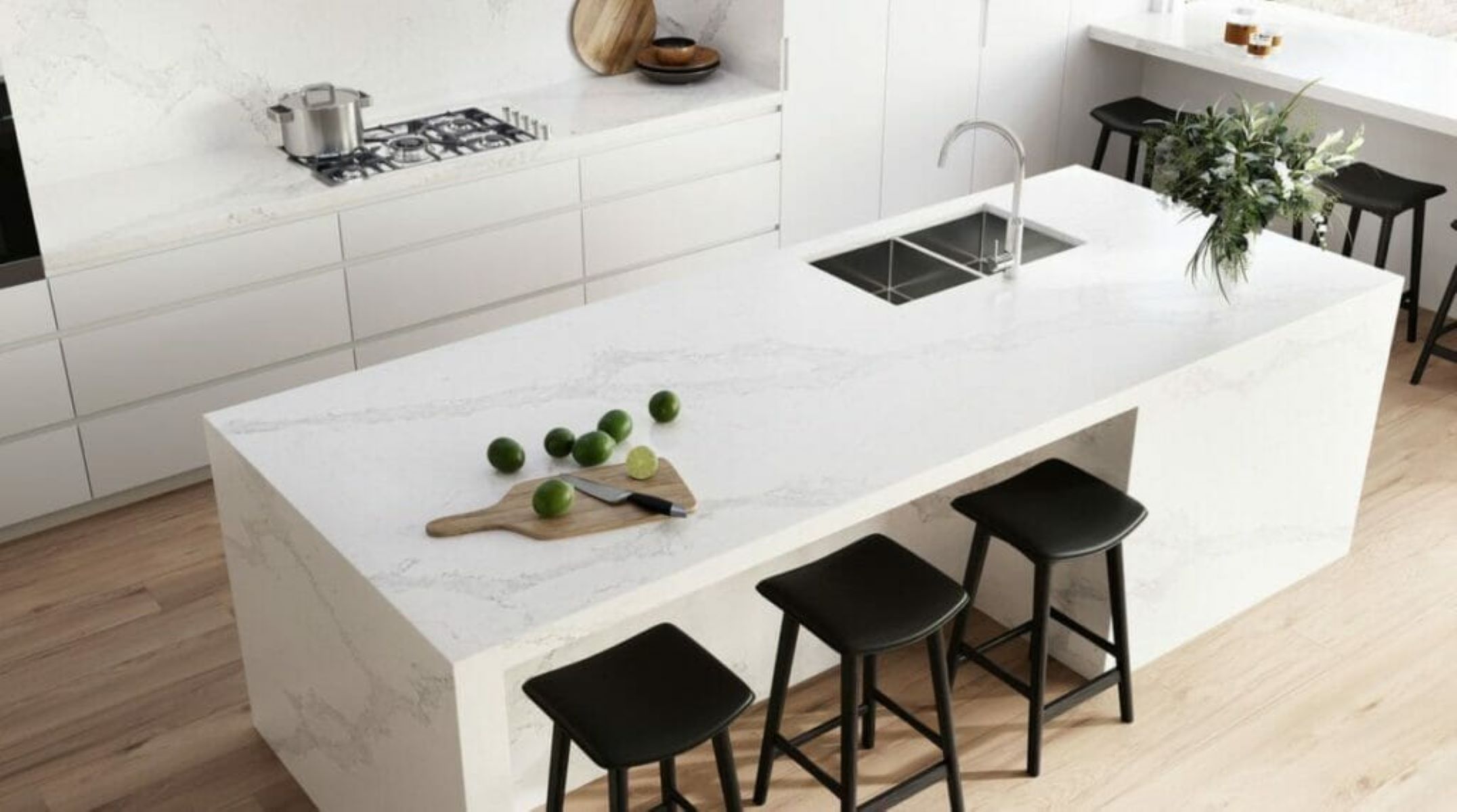
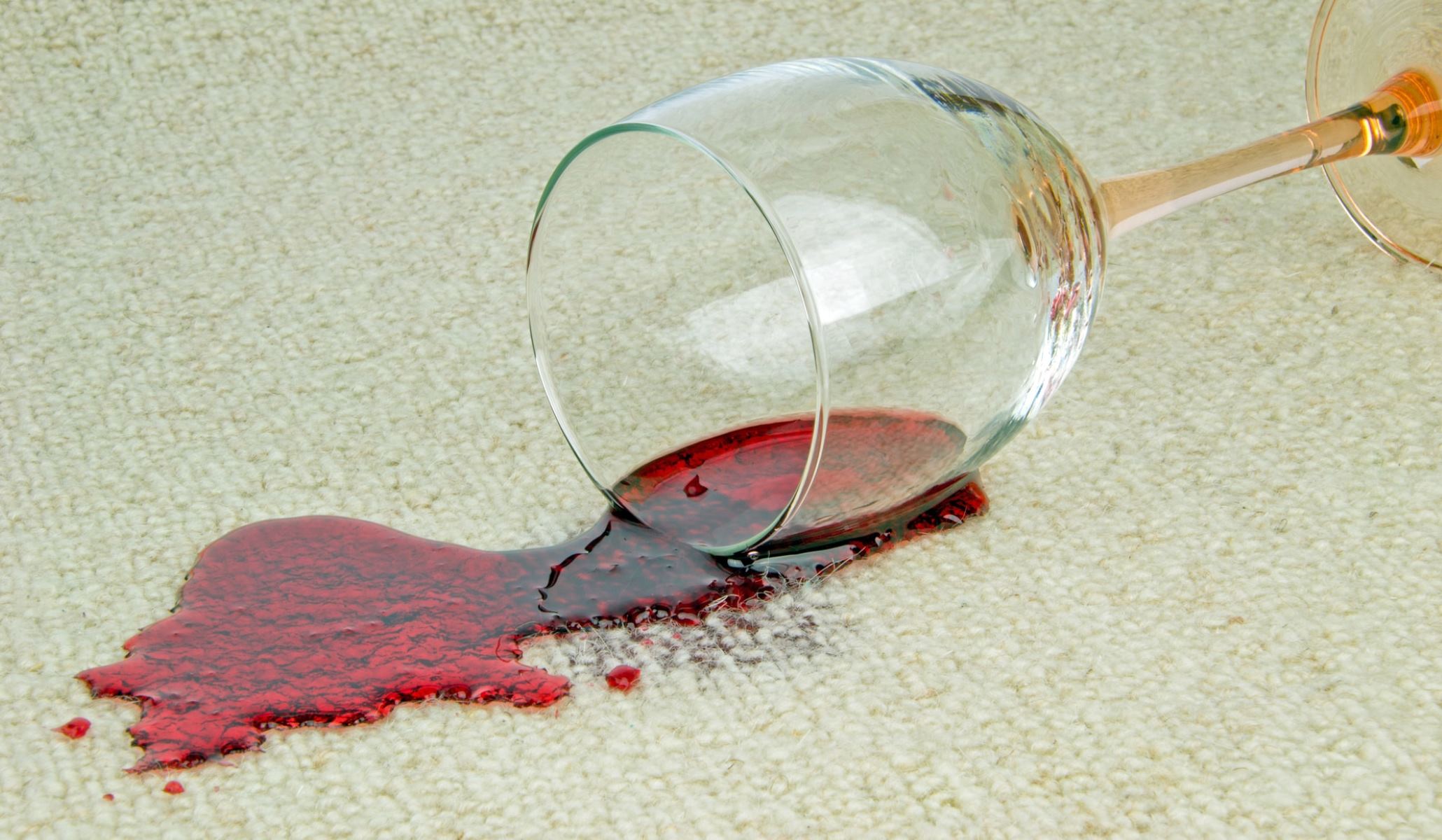
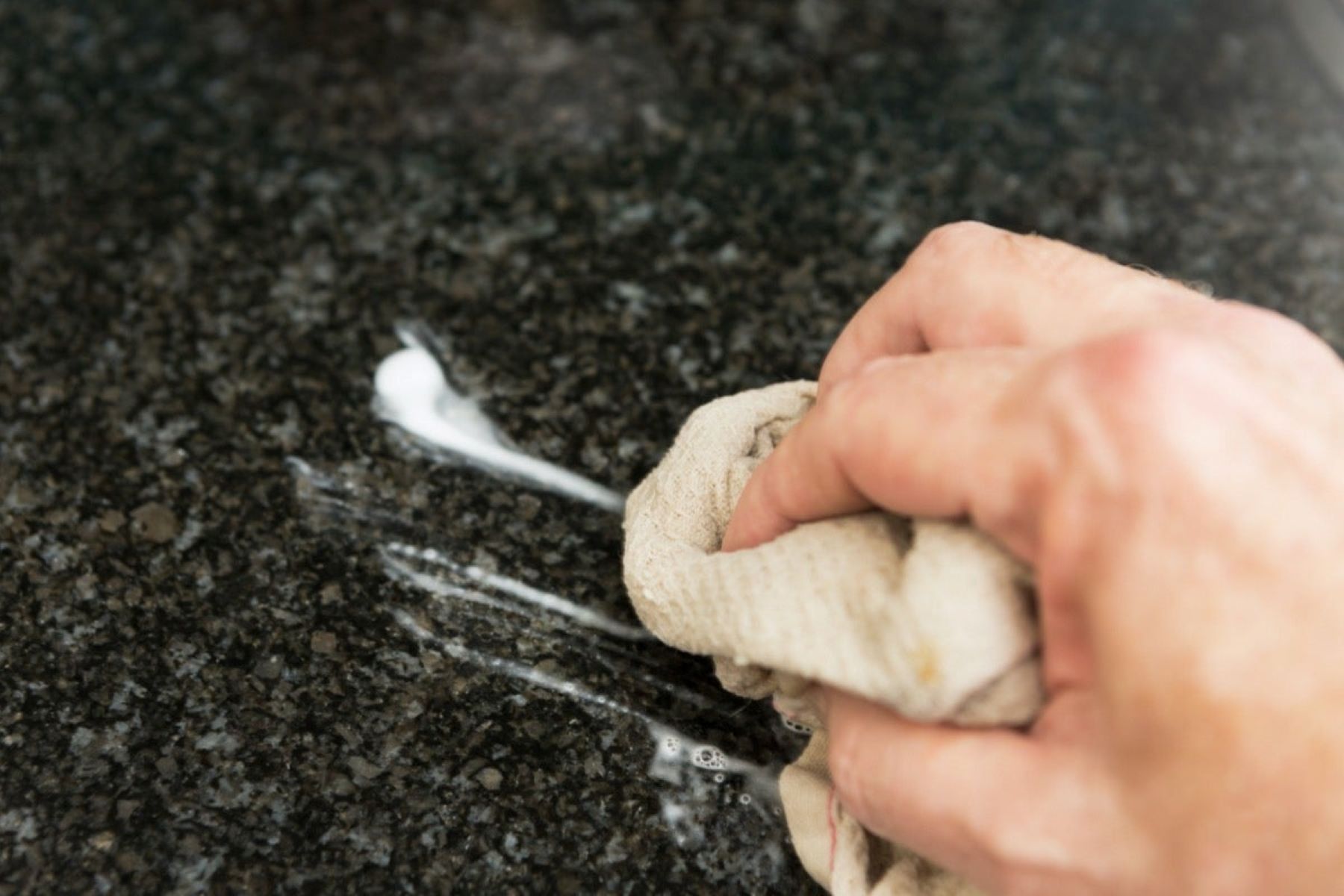
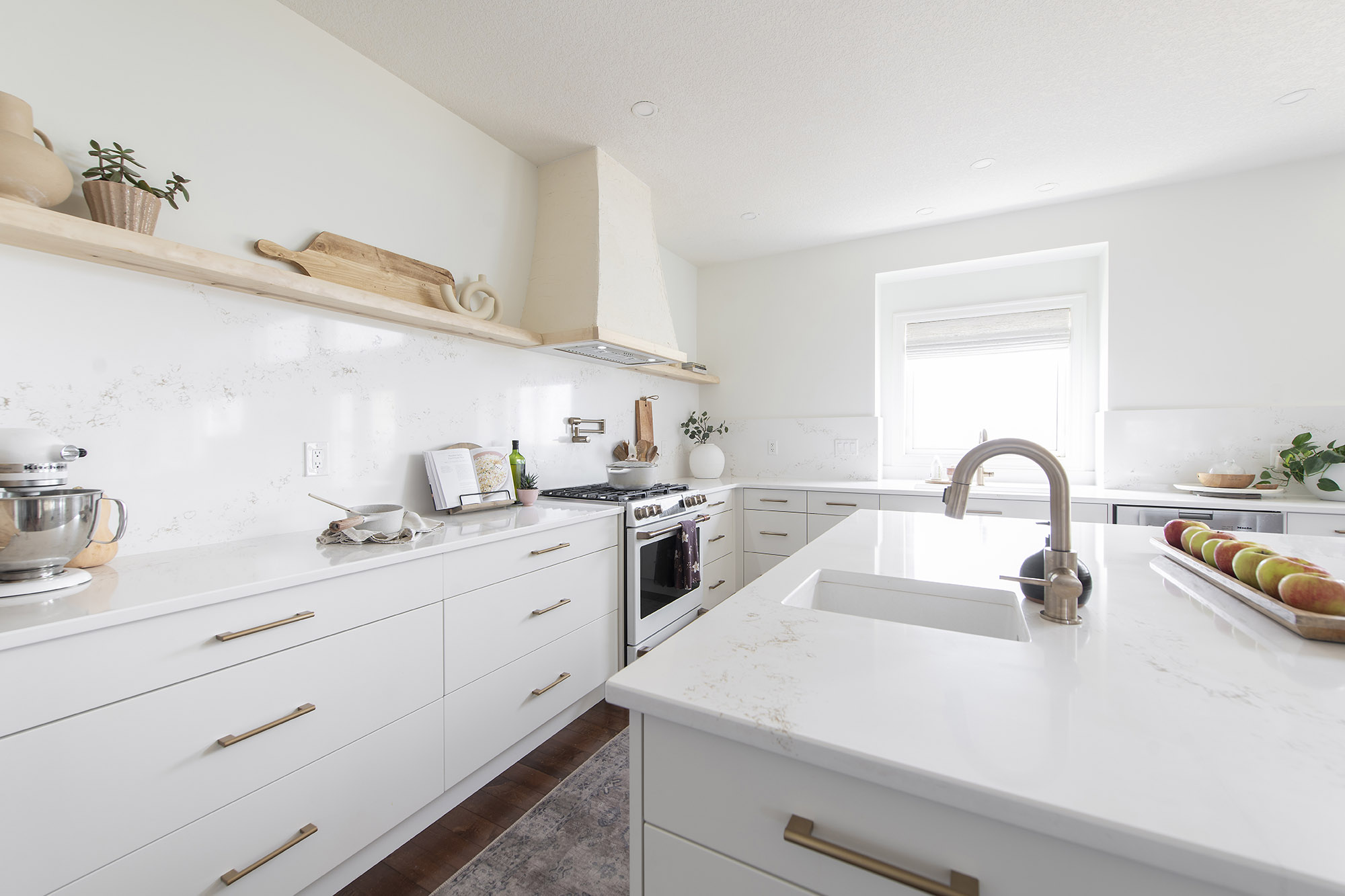
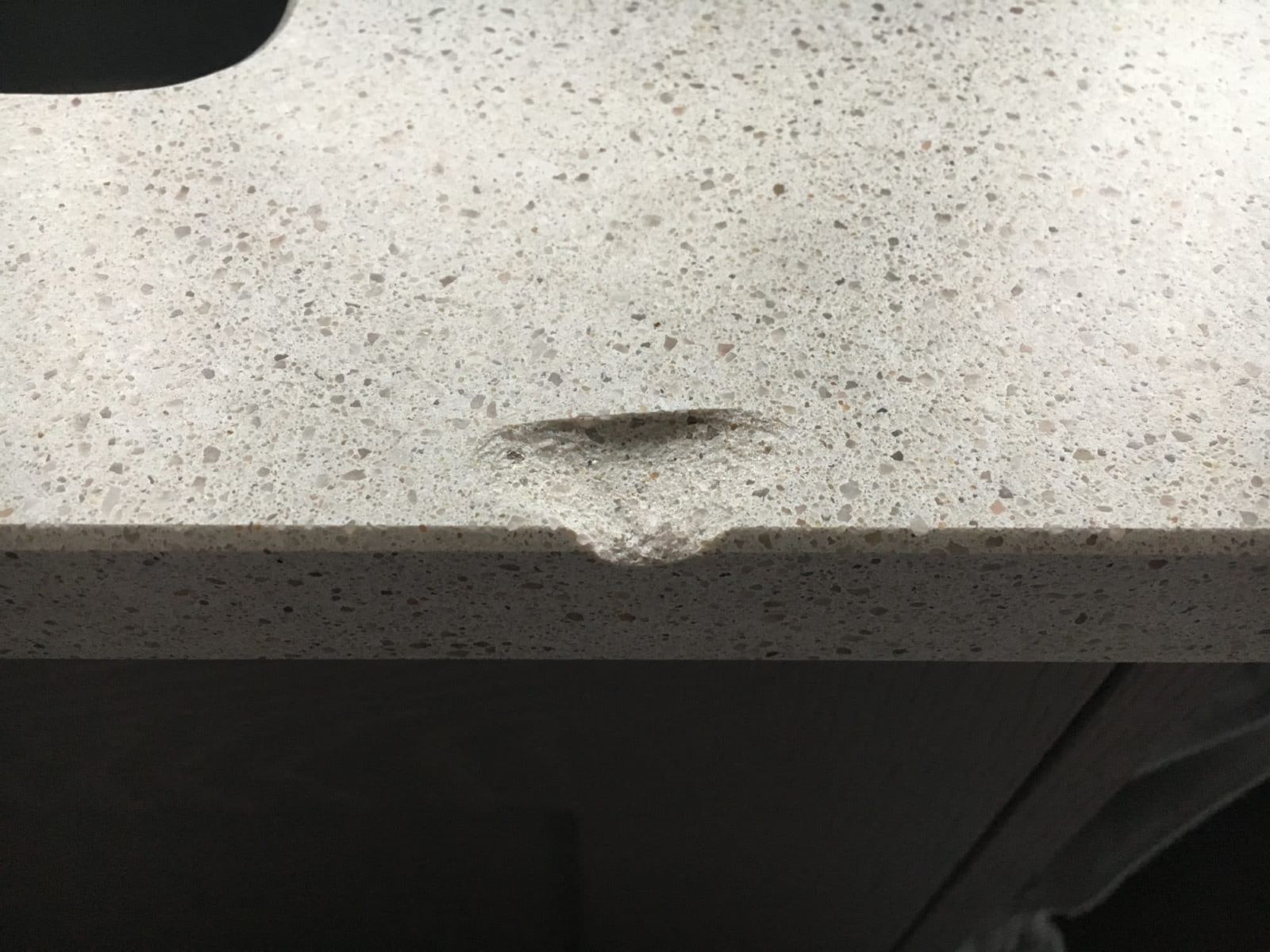

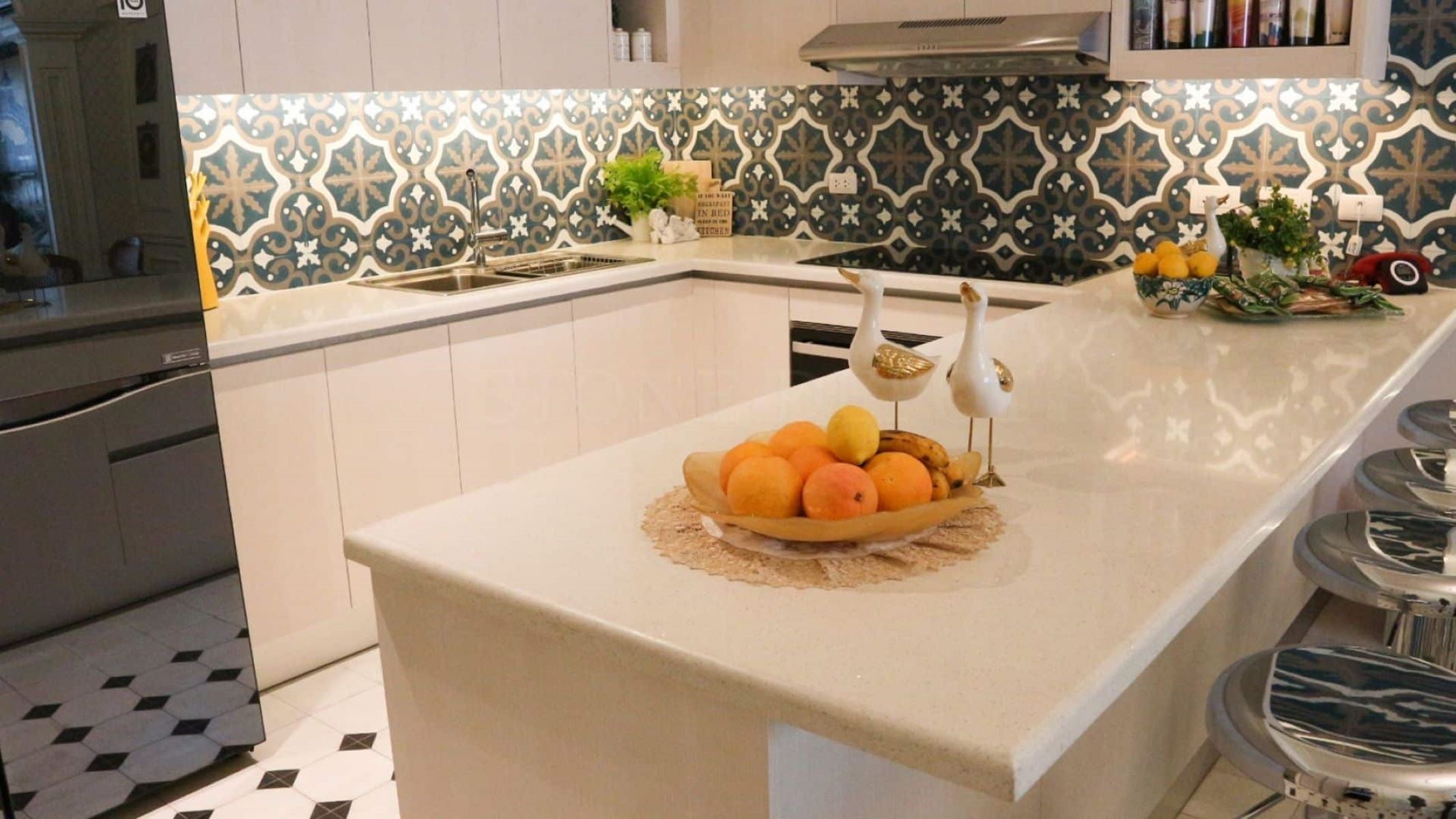

0 thoughts on “How To Clean And Disinfect Quartz Countertops”